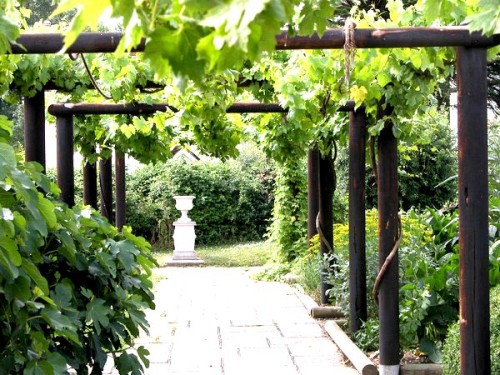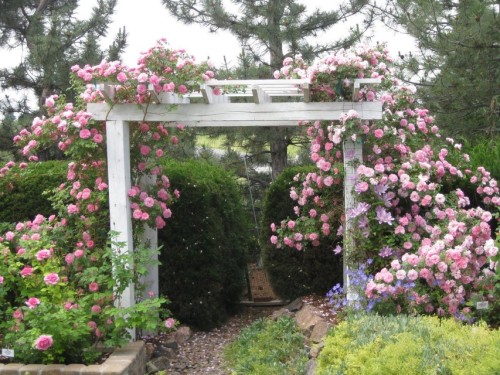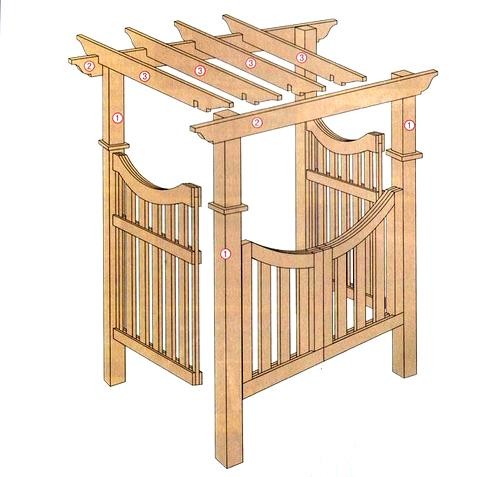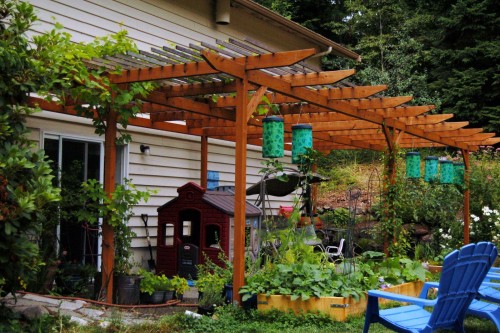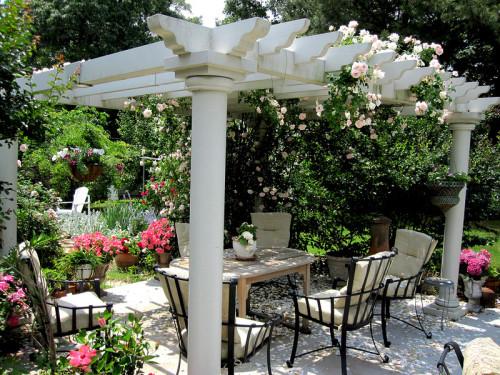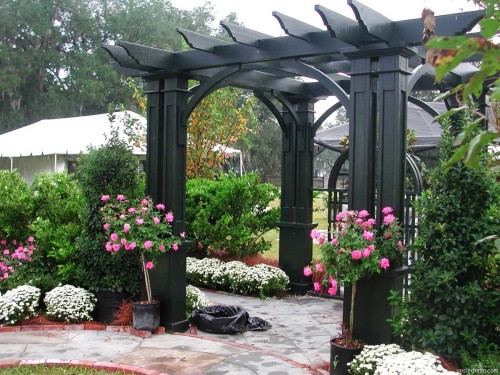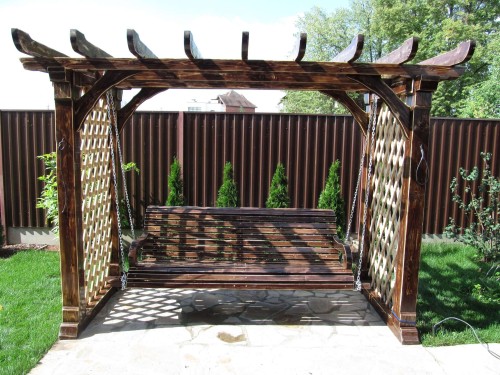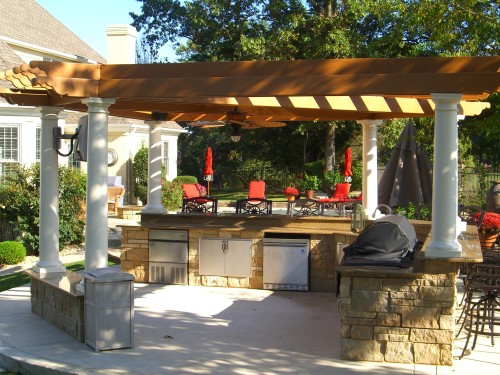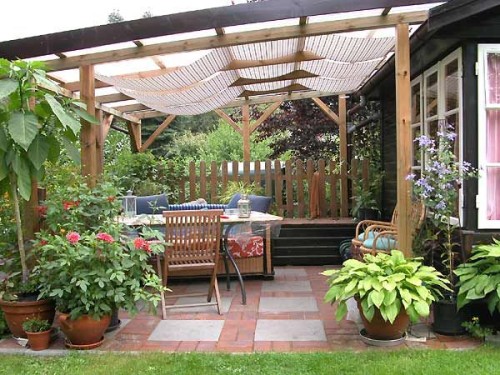
Pergola do it yourself Useful advice,Plot.

To create a cozy corner on the garden plot, you can accommodate the pergola there. Traditionally, in the east, it is equipped in the form of a tea pavilion or make the house adjacent to the house, providing a shady transition between the buildings. Pergola is an expressive element of the garden landscape - it will provide a shadow in hot summer days, hobs from curious glances, will create a comfortable atmosphere on the native and summer cottage. Successfully planning the device and the location of the pergola, you can give the garden elegance and make a note of romanticity in its atmosphere.
Content
Pragol species and designs
This decorative design in the form of an archer with transverse crossbars or a lattice canopy is a support for climbing plants and will harmoniously fit into the surrounding landscape. As a rule, to preserve the overall concept of the landscape design of the site, the garden pergola does not make the central part of the composition. So that this design does not compete with other buildings, it is appropriate to install it in a secluded garden corner, or to arrange it adjacent to the residential building. Regardless of the placement location, pergolas can be equipped with a barbecue or a barbecue area where you can cook in the outdoor, as well as swings, with a spawning room, benches.
Distinguish the following types of pergol:
- depending on the shape - rounded, broken shape, fan-shaped;
- by type of placement on the site, pergolas can be isolated in the form of individual structures, as well as structures adjacent to the building. They are used as a terrace, arbors or summer kitchens, as well as to create a shady corridor from the porch to the wicket;
- capital or collapsible structures.
Materials for pergola
Depending on the design of the site, pergolas are made from various materials - laid out of the stone or bricks, are peeled out of wood, they are blocked or welded from metal, and also performed as artificial plastic trees.
Wooden designs are most popular, as they organically fit into almost any style of landscape design, besides, building a wooden pergola does not take too much time.
Pergola from metal is beneficial to durability and durability. Metal support parts can also be combined with wooden slats for landscaping. With the proper care of pergola from these materials, seized by green plants, lasts on the site long enough.
Pergola from brick or natural stone is a fundamental structure that is distinguished by strength and durability. Such a design of pergola is unlikely to suit for a small garden, but it will become a spectacular decoration of a spacious household plot.
Gradually acquire the popularity of the design of plastic, which differ in low cost. Often, curly plants are powered by pergola in such a way that it becomes difficult to distinguish from which material it is made.
Functions of garden pergola
Pergola in the garden can perform the following functions:
- create a cozy corner for recreation, protecting from strangers, creating a shadow and coolness;
- promote the creation of a comfortable microclimate;
- zonate a plot. Several pergoles built on the site at an angle to each other will allocate separate functional zones - economic, for receiving guests, relaxation and solitude;
- impress the uniqueness and individuality of the territory;
- slimming some errors of buildings on the site, as well as mask technical buildings.
Selection of plants for pergola and rules for her gardening
Selecting and disembarking plants for vertical landscaping pergola, you can adjust the appearance of the composition, growth and direction of the living on it.
Traditionally, pergolas are used to support the decorative virgin or cultural grapes. For the creation of a "living wall", curly perennial plants are suitable, various varieties of decorative lian and ampel plants - they should be chosen taking into account climate. When choosing a type and variety of plants for pergola, it is also necessary to take into account the time and duration of their flowering, as well as a combination with other plants on the site.
Great Glicinia, curly roses and clematis compositions perfectly look great. Using large and small inflorescences of various plants, it is easy to get a variety of color combinations. You can also decorate pergola with the help of its chinese lemongrass, honeysuckle and ivy, binders, nasturtium and yellow-beard hops. From annual fast-growing plants, curly fragrant peas and fire-red beans are suitable.
To create a harmonious composition, lengthen the space surrounding the pergola. It is advantageous to shade her lined up shrubs. It should be borne in mind that plants for pergola, as a rule, need to be careful - periodic watering and feeding.
The construction of pergola do it yourself
The country area is easy to equip, setting a purchased collapsible pergola - either under the order according to the sketch provided. A wide selection of plastic and wooden products is available, as well as prefabricated metal structures. In addition, you can cheap and creatively decorate a plot, making pergola with your own hands. It is important at the same time to choose a convenient material in the work, as well as easy to build a design. Such inexpensive material, well-tenderly treated, is wood.
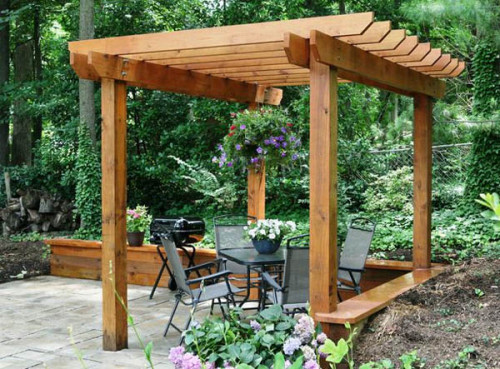
From the natural tree is not too difficult to equip with minimal costs of garden construction for every taste. In addition, at home, you can build pergola from several arches made of metal fittings or profile pipes, and interconnected crossbars.
For the construction of pergolas from wood, the following tools and materials may be needed:
- wooden bars for a cross section of 70x70 mm, for transverse beams 50x50 and for lateral beams 100x50 and 100x100 mm;
- top panels;
- nails and self-tapping screws;
- brackets and brackets;
- screwdriver;
- hammer;
- roulette;
- master OK;
- antiseptic for wood;
- morilka, decorative varnish or paint;
- brush;
- concrete solution;
- solution tank;
- shovel.
Preparatory work
To determine the amount of material necessary for the construction of pergola, make a design project, draw a scheme on paper.
For the construction of pergola, it is possible to use wood treated under pressure - it is sold in garden centers. Otherwise, for protection against atmospheric influences, wooden bars must be carefully treated with antiseptic solution.
After purchasing and preparation of materials, it is necessary to prepare the place selected to accommodate the future design - to align the ground under the construction, as well as put markup.
How to install pergola
For the construction of pergolas on the site it will be necessary to make the following works:
- first, you need to dug the recesses for the installation of the supports (a pits of about 60 cm depstituate are suitable for fixing the structure of a small size) - the support pillars of pergola will be placed in them. Bruks are fixed in recesses, poured them with concrete solution to impart resistance;
- for reliable fixation of pillars, you need to wait a few days - for the complete pouring of the concrete, you will need two or three days. After that, you can start attaching horizontal beams to supports - for this you use screws, as well as brackets and brackets. At the same time, it is necessary to pay special attention to the quality of the compounds from which the strength of the structure will depend. The most reliable way is the thickest fastening of wood - by dense insertion into the prepared holes (grooves) of figured protrusions (spikes). Such a method can be securely and steadily fixing the beams;
- next to horizontal beams with nails fasten the transverse, having them with equal intervals "into oblique" to increase the stability of the structure (under the influence of the impacts of the wind);
- if you want to form a grid pavilion, attach to the lateral parts of the design of the grinding panels - they will act as a support for curly plants, which will subsequently create the effect of the green wall. It should be borne in mind that the heat panels should be attached to the level of the ground level, as they do not tolerate high humidity. In addition, the wire or rope can be pulled between the racks;
- the erected design is stained in the selected paint tones for external work (oil paint or alkyd enamel), or are covered with a veil and lacquer.
Pergola - Photo






